
If you haven’t checked out the base set Good analysis, do that now!
In Epic, you really need to choose one of only a few offensive methods to get in your damage and win. You can go with Airborne, Breakthrough, burn, swing wide, control, or freeze. This deck chooses to exploit the fact that Good has the best airbornes in Epic and use this fact to its advantage to beat out other Airborne strategies, as well as fogging direct damage (and some Breakthrough) with life gain. It can’t really do anything about freezing except for Ceasefire. Make sure you’re wiping the field regularly to stop their damage buildup on the ground from getting too intense.
Common Plays
Use your cards listed in the decklist’s Offense category, to swing in the air, dealing damage. Here’s how you should do this in general, based on a few factors:
- Always swing if the opponent has no blockers in the air. Use just one of your champions to attack if you think you might have to block.
- With Gold Dragon, swinging into air blockers is fine if you can gain some health back. Try to keep the Dragon up so you don’t lose it.
- Ambush in Angelic Protector (or use Brave Squire) on your own turn if they block your air and it would die. It now won’t die.
- Don’t try to use removal when attacking as a group. You’ll still be counted as blocked. Use group attacks if you need to reduce the opponent’s opportunities to play gold cards.
- Always use “bait” cards before your MVPs. Bait is stuff that the opponent must kill such as High King, or else they’re going to eat dirt every turn.
- Thundurus should usually be played before Gold Dragon. It’s bait, Gold has blitz anyway, Thundurus can block for a turn, and it doesn’t matter if it’s telegraphed since Gold Dragon is worth more to you.
- Always try to pair Lord of the Arena with Faithful Pegasus over other humans since it gives you 13 damage in the air.
- High King and other removal should always target firstly, threats, then air blockers, then other things. Threats are other things similar to High King that force you to respond or the opponent will gain too much ground.
- Use Brave Squire on your air attacks when you see an opening, since you get the protection and the (practically) double damage.
- Ceasefire is best used when an opponent starts with their weakest champion.
Offense Priority
Play attackers in this order of priority:
- Angel of Light/MVP if you will die without gaining the life.
- Angel of Mercy if an MVP is dead (grabbing in Offense Priority order)
- Thundurus if playing Gold Dragon next turn, or needing bait for either MVP
- MVP (Avenging Angel and Gold Dragon)
- Angelic Protector if an MVP is attacking on your turn. Or if one is out and it’s the opponent’s turn and they are attacking.
- Angel of Light if you have nothing else.
- Angel of Mercy if you have nothing else (though at this point, you can probably resurrect any of the above).
Opponent Turn Priority
General case for how to spend your gold on an opponent’s turn:
- Inner Peace/Angel of Light if you will die without the life gain.
- Stand Alone if you will die without it or as “nuke timing” to open up a blitz attack on your next turn
- Ceasefire if the opponent will attack with a total of 10+ damage outside their first attack, especially if they attack with their weakest first.
- Banishment if something must die on the opponent’s turn to live/protect something, etc.
- Ambush blocker if you will die without it. (Choose the least valuable)
- Resurrection/Angel of Mercy if an MVP is dead or will die
- Brave Squire/Angelic Protector if an MVP, Thundurus or Angel of Mercy (with those targets) might die
- Noble Unicorn
- Use various Draw 2 effects if your own hand is 3 or less.
- Ambush in an Attacker setup (see Offensive Priority)
- Courageous Soul to set up a decent attacking turn.
- Other things (Inner Peace because you want to, Angel of Light because why not, etc.)
Legend for deck keypoints:
- OPP – Counts as playable on the opponent’s turn. This is essential to keeping good rhythm and affecting game play every single turn. Doesn’t count re-usable.
- AIR – Airborne, as is required for this strategy to work. Higher number means the deck has lower overall Power but is more consistent.
- DRW – Draws at least 2 cards, or is a draw engine. Required to keep playing cards every turn including on the opponent’s turn, especially if you’re board wiping.
- PRO – Protection. This could be anything from unbreakable to untargetable but basically means this unit provides or has protection from enemy cards so that the main strategy won’t crumble.
- MVP – Don’t squander these as they’re your best cards.
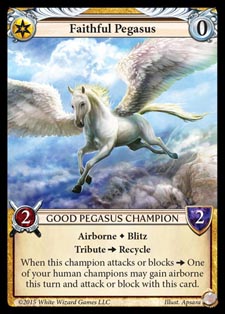
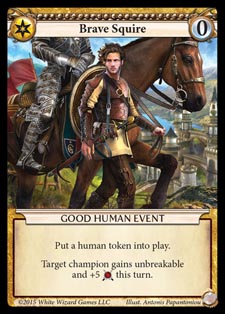
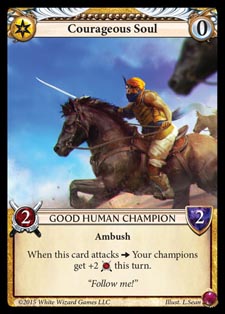
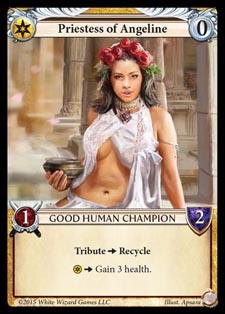
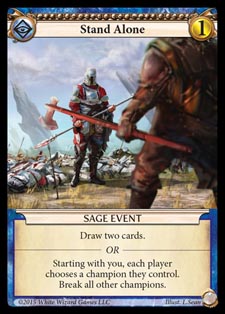
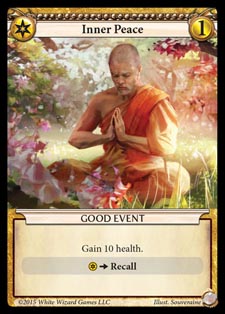
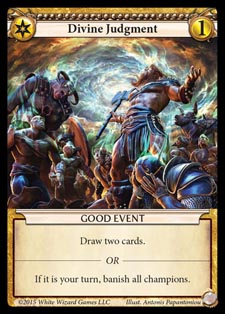
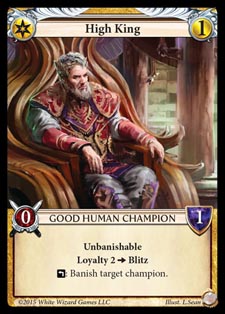
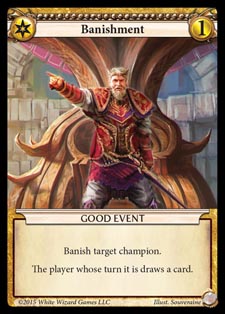
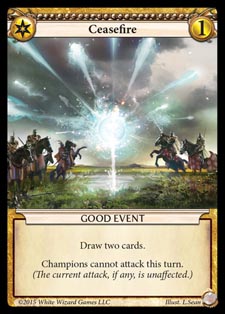

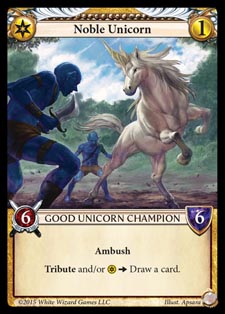
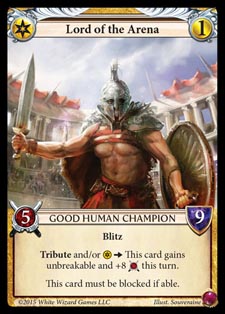
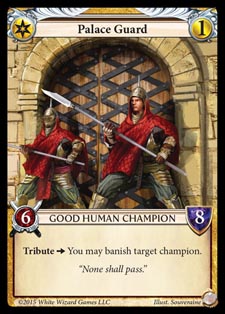
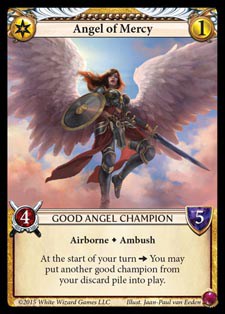

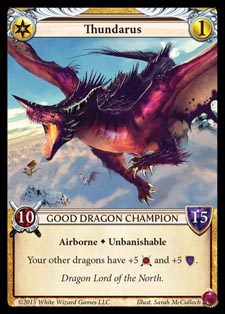
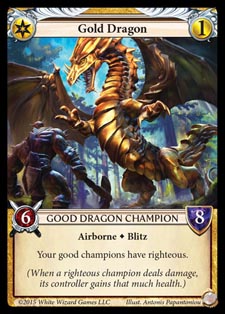
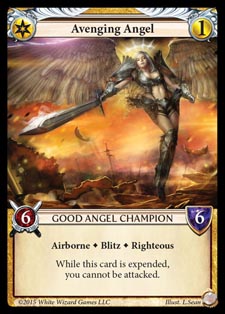
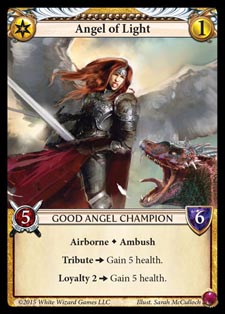
Key Point stats
Keypoint totals:
- OPP – 12 unique, 36 total cards. 60% of the deck works on the opponent’s turn.
- AIR – 7 unique, 21 total cards. 35% of the deck swings in the air.
- DRW – 5 unique, 15 total cards. 25% of the deck can give net hand advantage after it’s played.
- PRO – 6 unique, 18 total cards. 30% of the deck can protect you or your cards.
Intersection – 150% total, spillover (intersection) of 50%. Cards, on average have 1.5 of the deck’s key points on each card. Therefore each draw in this deck has a quality rating of 1.5. This could potentially be increased by using some Sage cards but would reduce ally and loyalty probabilities.
Card Changes
Right now, there are only 3 cards (5% of the deck, or 1/20 draws) that can confound loyalty/ally. Using Memory Spirit which is the first choice, would drop that to 1/10 cards but may not be so bad.
- Loyalty/Ally – 6 uniques, 18 total cards. 30% of the deck requires at least two other Goods.
- Removable – 3 uniques, 9 total cards. 15% of the loyals can be removed if something better is used.
- Confound – 1 unique, 3 total cards. 5% of the deck screws up 30% of the deck. Very low screw rate and basically only ever need the 3 minimum cards to activate a loyalty.
Removable Cards:
- Inner Peace. I mentioned this in the deck list but Inner Peace can be removed for something like Memory Spirit (Sage) which hits AIR, OPP and can re-use events such as Ceasefire or your AOEs. Right now, it’s being used to repeatedly trigger Loyalty/Ally over and over, so this may be the last one you attempt to remove. If it does get removed and you want something similar in its place, go for Mighty Blow (Wild, DRW, OPP) which has one keypoint over Inner Peace and can slap down at the right moment to win the game 2 turns earlier. When the opponent is at 14-16 life and you have one attacker, Mighty Blow is excellent. Its uses are going to be mostly limited to openings that you have created, however.
- Palace Guard. Basically just here for the body. It’s a great card but if an attacker such as Winter Fairy (Sage, AIR, DRW) goes here, it can give draw. The deck has a lot of removal as-is.
- Lord of the Arena. It’s re-usable Palace Guard so you should consider keeping this over it if you remove only one. And definitely remove this before Inner Peace as it’s one of the repeated-use ally cards. While its 2-card combo is really amazing, Lord of the Area is basically just removal you have to work for and is worse than High King most of the time. Though it and Palace Guard are both good blockers and that’s why both are still in the deck. Possibly remove for Winter Fairy, Wave of Transformation, or Kong if you really want something beefy that can kill. I recommend keeping Lord over Kong since it has blitz. Try to replace with something that has ambush or blitz and can be a legit attacker (specifically, Memory Spirit if you don’t have it in already).
- Priestess of Angeline. She’s really just here for the extra life on top of Angel of Light and Inner Peace. If you do replace cards such that you now have at least 6 Sage that cost gold, you can run three Muse (Sage, OPP, DRW) over Priestess of Angeline.
This is also covered in “Deck Stats” but here is a comprehensive list of the major cards recommended for this deck if you swap anything (within Base Set).
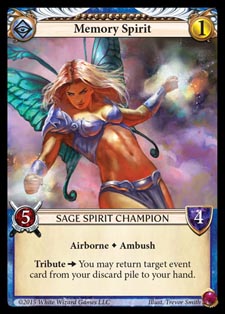

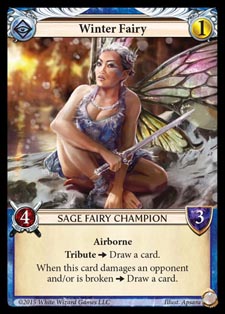
Listed in order of desirability. Check below for what to replace and the updated Deck Stats.
Replace:
- Palace Guard
- Lord of the Arena
Deck Stats:
- OPP +5%
- AIR +5%
- Overall +10% (change to intersection/card quality)
Replace (only if using 6 gold Sage):
- Priestess of Angeline
Deck Stats:
- OPP +5%
- DRW +5%
- Overall +10% (change to intersection/card quality)
Replace:
- Palace Guard
- Lord of the Arena
- Consider Memory Spirit and Muse first!
Deck Stats:
- AIR +5%
- DRW +5%
- Overall +10% (change to intersection/card quality)
Stats with All Changes
- OPP – 14 unique, 42 total cards. 70% of the deck works on the opponent’s turn.
- AIR – 9 unique, 27 total cards. 45% of the deck swings in the air.
- DRW – 7 unique, 21 total cards. 35% of the deck can give net hand advantage after it’s played.
- PRO – 6 unique, 18 total cards. 30% of the deck can protect you or your cards.
Intersection – 180% total, spillover (intersection) of 80%. Cards, on average have 1.8 of the deck’s key points on each card. Therefore each draw in this deck has a quality rating of 1.8.
New loyalty problems:
- Loyalty/Ally – 4 uniques, 12 total cards. 20% of the deck requires at least two other Goods.
- Confound – 4 unique, 12 total cards. 20% of the deck screws up 20% of the deck. Basically, you’ll need 4 cards in hand most of the time to activate one Loyalty.
- Reminder that technically Muse doesn’t cause a problem for the Ally cards, only Loyals, so this math is slightly off (looks worse than it is).
Stats with 2 Changes
Using only the first two changes, Memory Spirit and Muse, the stats become the following:
- OPP – 15 unique, 45 total cards. 70% of the deck works on the opponent’s turn.
- AIR – 8 unique, 24 total cards. 40% of the deck swings in the air.
- DRW – 6 unique, 18 total cards. 30% of the deck can give net hand advantage after it’s played.
- PRO – 6 unique, 18 total cards. 30% of the deck can protect you or your cards.
Intersection – 170% total, spillover (intersection) of 70%. Cards, on average have 1.7 of the deck’s key points on each card. Therefore each draw in this deck has a quality rating of 1.7.
New loyalty problems:
- Loyalty/Ally – 4 uniques, 12 total cards. 20% of the deck requires at least two other Goods.
- Confound – 3 unique, 9 total cards. 15% of the deck screws up 20% of the deck. You’ll need 4 in hand for some loyalties but not all of them.
- Reminder that technically Muse doesn’t cause a problem for the Ally cards, only Loyals, so this math is slightly off (looks worse than it is).
My final thoughts on this deck are that it’s very fun to play and when it “goes off” it’s almost sure to win. It has to go off, though. Most specifically, the trends I notice winning the most games are the following:
- Using at least 1 MVP for at least 3 of the game’s turns total
- Nuking for at least +3
- Drawing at least 6 extra cards off things like Noble Unicorn
- Using Thundurus’ ability ever
- Attacking in the air 5 turns
If you can do any of these, you usually end up winning. If you can do several, you can significantly increase the chances that you win. Though Good is widely regarded as the worst pure alignment in base set (and I can agree with that), the problems it has can be mitigated if constructed and played correctly. This is my attempt to put it as on-par with other decks as possible. By giving it minimum 1.5 card quality, it means the draws in this deck go significantly farther than a generic Good deck. At the 1.7 modified version (which I prefer, actually) the card quality is so significant that you can get 2-3 of those winning points bare minimum every game.
Its goals seem good enough that the card quality is leaning more toward an objective measure of how good it is, rather than a pure synergy assessment. Swinging in the air, drawing cards and playing on the opponent’s turns are some of the most fundamentally necessary things in all of Epic. Protecting the ability to swing in the air is very nearly the same as doing more of it as well.

Leave a comment